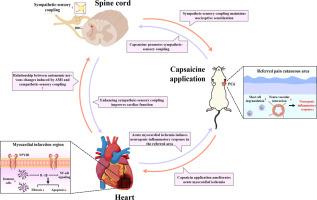Neuroimmunological basis of sympathetic-sensory coupling modulation via capsaicin to restore cardiac function in an acute myocardial ischemia rat model
IF 8.3
1区 医学
Q1 CHEMISTRY, MEDICINAL
引用次数: 0
Abstract
Background
Acute myocardial ischemia (AMI) carries a high risk of heart failure and subsequent mortality. However, current therapies remain limited by suboptimal drug efficacy and high costs, prompting exploration of alternative strategies, such as remote therapy. Capsaicin is a natural extract from red chili peppers. Remote therapy using it as the primary component has demonstrated efficacy in AMI treatment. However, this specific mechanism requires further exploration.
Purpose
Here, we investigate the therapeutic effects of remote capsaicin application therapy on AMI and elucidate the underlying neuro-immune interactions responsible.
Methods and results
We applied capsaicin cream to the ventral forelimb of rats, finding that it enhanced the sympathetic-sensory coupling (SSC) state in the skin and dorsal root ganglia (DRGs) (C8–T6), improving cardiac function over 28 days. Localized yohimbine (YOB) injections in skin /DRGs confirmed the critical role of the SSC structure. Mechanistically, capsaicin-enhanced SSC increased neuropeptide Y-positive (NPY+) nerve fiber density in peri‑infarct myocardium, concurrently shifting cardiac NPY receptor expression toward predominant NPY2R. Inhibiting cardiac NPY2R expression eliminated the functional benefits of capsaicin. In vitro co-culture of H9C2 cardiomyocytes and RAW264.7 cells showed functional NPY2R localization in cardiomyocytes. Activation of cardiomyocyte NPY2R promoted macrophages to secrete the anti-inflammatory factor IL-10, reducing hypoxia-induced cardiomyocyte apoptosis. Adeno-associated virus (AAV)-mediated overexpression of NPY2R in cardiomyocytes mimicked the cardioprotective effects of capsaicin. RNA sequencing revealed that NPY2R overexpression inhibited the IL-1β-induced NF-κB pathway in the heart. Flow cytometry confirmed these changes were due to reduced M1 macrophages and neutrophil infiltration in the infarct area.
Conclusion
Capsaicin enhances the segmental SSC structure to protect cardiac function in AMI rats, primarily associated with the improvement of the immune microenvironment induced by NPY+ nerve and NPY2R activation in the heart.

辣椒素调节交感-感觉耦合恢复急性心肌缺血大鼠心功能的神经免疫学基础
背景:急性心肌缺血(AMI)具有心力衰竭和随后死亡的高风险。然而,目前的治疗方法仍然受到不理想的药物疗效和高成本的限制,促使探索替代策略,如远程治疗。辣椒素是从红辣椒中提取的天然物质。以其为主要成分的远程治疗在AMI治疗中已被证明有效。然而,这种具体的机制还需要进一步的探索。目的探讨辣椒素远程应用治疗急性心肌梗死的疗效,并阐明其潜在的神经免疫相互作用。方法与结果将辣椒素乳膏应用于大鼠腹侧前肢,28 d后发现辣椒素乳膏可改善皮肤和背根神经节(C8-T6)的交感-感觉耦合(SSC)状态,改善心功能。局部育亨宾(YOB)注射在皮肤/DRGs中证实了SSC结构的关键作用。在机制上,辣椒素增强的SSC增加了梗死周围心肌的神经肽y阳性(NPY+)神经纤维密度,同时将心脏NPY受体的表达向主要的NPY2R转移。抑制心脏NPY2R表达消除了辣椒素的功能益处。H9C2心肌细胞与RAW264.7细胞体外共培养,心肌细胞中NPY2R功能定位。激活心肌细胞NPY2R可促进巨噬细胞分泌抗炎因子IL-10,减少缺氧诱导的心肌细胞凋亡。腺相关病毒(AAV)介导的心肌细胞NPY2R过表达模拟了辣椒素的心脏保护作用。RNA测序结果显示,NPY2R过表达抑制了il -1β诱导的NF-κB通路。流式细胞术证实这些变化是由于梗死区M1巨噬细胞和中性粒细胞浸润减少所致。结论辣椒素增强AMI大鼠节段性SSC结构,保护心功能,主要与改善心脏NPY+神经和NPY2R激活诱导的免疫微环境有关。
本文章由计算机程序翻译,如有差异,请以英文原文为准。
求助全文
约1分钟内获得全文
求助全文
来源期刊

Phytomedicine
医学-药学
CiteScore
10.30
自引率
5.10%
发文量
670
审稿时长
91 days
期刊介绍:
Phytomedicine is a therapy-oriented journal that publishes innovative studies on the efficacy, safety, quality, and mechanisms of action of specified plant extracts, phytopharmaceuticals, and their isolated constituents. This includes clinical, pharmacological, pharmacokinetic, and toxicological studies of herbal medicinal products, preparations, and purified compounds with defined and consistent quality, ensuring reproducible pharmacological activity. Founded in 1994, Phytomedicine aims to focus and stimulate research in this field and establish internationally accepted scientific standards for pharmacological studies, proof of clinical efficacy, and safety of phytomedicines.
 求助内容:
求助内容: 应助结果提醒方式:
应助结果提醒方式:


